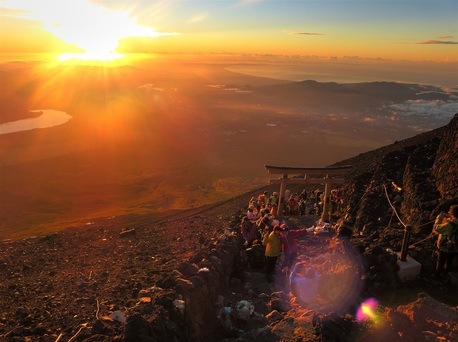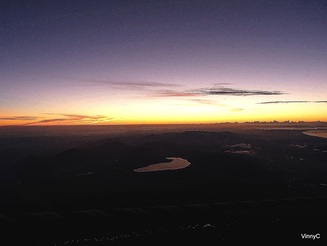The Mt. Fuji Experience
"No one climbs it from the bottom..." people told me, Japanese and foreign alike. But for some reason, while sitting Shinjuku Station on the afternoon prior to the climb and deciding which bus to take, saving the 1570 Yen (~$20) and hiking straight from Fuji Yoshida station sounded like a good idea. I had also heard about this "awesome" trail, called the Yoshida Trail. This trail is the old trail used by Japanese pilgrims making the journey to the top of Mt. Fuji before there ever was such a thing as the 5th station road. I figured seeing the old shrines in the woods and climbing Fuji the old style would be great, and 21 km before sunrise wouldn't be too much of a challenge if we started early enough the night before.
| To rewind a little bit, Mt. Fuji is both a volcano and the highest mountain in Japan, with an official elevation of 3,776 m (12,389 ft). Fuji-Yoshida station on the JR Fujikyuko Line is technically the closest station, though many more buses depart from Kawaguchi-ko. Though not quite sea-level, Fuji-Yoshida and Kawaguchi-ko Station sit a cool 9839 ft below the summit, at an elevation of about 2550 ft. The route most chosen, however, is taking a bus to the 5th station, chopping almost 5,000 feet of vertical elevation from the full climb. What is the "5th station"? Before there was such a things as buses and cars and cheap ways to the top, Pilgrims made there way from the small town at the bottom. Starting at Sengen Shrine (shown in the picture at right) they would climb the full 9839 feet of elevation to the summit over the course of a day or two. Along the way were "stations" from one to ten (one being the beginning of the trail and ten being the summit), which served tea, sake, and food, and provided places to spend the night. After the Subaru 5th Station was constructed slightly North of the old 5th station, and a road paved to it, the stations below soon became far less needed. Now, there still remains a tea house (Naka-no-chaya) closer to Sengen shrine, but all that remains of the 2nd, 3rd and 4th stations are mysterious dilapidated wooden huts, and the occasional overgrown shrine. |
| | Not that I didn't enjoy the shrines, passing by them at warp speed on the way to the summit, but something about them was rather creepy at 11:00 p.m. with a dim flashlight. We did, however, make a short stop at the Torii Gate, honoring the monkeys and praying for safe travel to the summit. As we went further into the night however, and higher up the mountain, the combination of cold sweat and decreasing temperature made for a less than pleasant experience. When we reached the 5th station (the lowest station that still provides "services" for climbers), were exhausted and sweat drenched, so we bought a cup-o'-noodles for 300 Yen (~$3.80) and some water for 200 Yen. This was slightly before midnight. "Five hours to go..." I thought. Could I make it? During the day at a lower elevation it would be an easy feat, but increasing exhaustion, and thinner and colder air were conspiring to make me second guess my choices of climbing through the entire night. |
And alas, here are where things got difficult. I had all I could do to put one foot in front of the other on the steep, never ending zig-zag leading up the north side of Mt. Fuji, and thus I have no pictures from this time. I stopped from time to time to buy an increasingly more expensive cup of tea (~400 Yen) for warmth, but other than that I continued the slow drudge for fear that I might miss the one thing that I had expended all this effort on. The one motivator I had was the slow and steady zig-zagging line of LED headlamps that reminded me I was not alone in my quest to reach the top before sunrise. Along the way I passed people sleeping on the the side of the trail despite the 8 C temperature and the slow, biting wind. Some people were using small oxygen containers to ward off the effects of altitude sickness, but I felt that was slightly unnecessary and costly.
| The dim glow of dawn slowly illuminating the rocky trail both excited me and scared me. At 4:30 a.m. I was confident that I could make it, if only I could get past these obnoxious tour groups! At some points the steep and rocky trail was no wider than a person, and traffic jams ensued. At these points, I, along with others scared to death they would miss the one thing they came for, scrambled quickly past the slow line of people in an effort to reach the top before the 5:05 a.m. bewitching hour. At long last, and completely out of breath, I found a corner of dusty volcanic rock at the summit somewhat void of people. The cheerful beep of the camera and the first shot of the pre-sunrise sky told me it was 4:46 a.m. I had made it. The new camera and a little HDR made a few of the shots look heavenly. Also included below is the Youtube video I shot, originally in HD. |
As for the descent, the length of the trail is considerably longer due to the 50 some-odd cutbacks the trail makes. This is the way they bring some of the supplies up to the top via small truck, but it's very taxing on the knees. During the descent I was entering my 11-12th hours of climbing, so I was very happy with a slow and steady pace. By about 8:30 a.m., I was at the Fuji-Subaru 5th station, the place where buses drop off massive groups of people who start their hike from 7500 feet. I however, took pride in knowing that my 13 hour sunrise hike was as close as anyone can get to the full Mt. Fuji experience.



 RSS Feed
RSS Feed